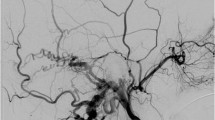Abstract
The commonly used Borden and Cognard classification systems for the prediction of clinical behavior of cranial dural arteriovenous shunts focus on the venous drainage, particularly the presence of leptomeningeal venous drainage, and on the direction of flow, particularly the presence of retrograde flow. In addition, the latter includes ectasia and spinal drainage as criteria of two distinct grades. However, none of the above classifications (a) differentiates direct from exclusive leptomeningeal venous drainage, (b) considers cortical venous congestion as a factor potentially associated with an aggressive clinical course, and (c) anticipates ectasia in shunts with a mixed dural-cortical venous drainage (type 2). In this study, we analyzed the angiographic images of 107 consecutive patients having a cranial dural arteriovenous fistula with leptomeningeal venous drainage, based on a newly developed scheme. This scheme, symbolized with the acronym “DES,” groups the dural shunts according to three factors: directness and exclusivity of leptomeningeal venous drainage and signs of venous strain. According to the combination of the three factors, eight different groups were distinguished. All analyzed cases could be assigned to one of these groups. Directness of leptomeningeal venous drainage expresses the exact site of the shunt (bridging vein vs sinus wall), whereas exclusivity expresses venous outlet restrictions. All bridging vein shunts had a direct leptomeningeal venous drainage. Almost all bridging vein shunts and all “isolated” sinus shunts had an exclusive leptomeningeal venous drainage. Venous strain, manifested as ectasia and/or congestion, denotes the decompensation of the cerebral venous system due to the shunt reflux. The comparison of the presented concept with the currently used classifications highlighted the advantages of the former and the weaknesses of the latter.










Similar content being viewed by others
References
Borden JA, Wu JK, Shucart WA (1995) A proposed classification for spinal and cranial dural arteriovenous fistulous malformations and implications for treatment. J Neurosurg 82(2):166–179
Cognard C, Gobin YP, Pierot L, Bailly AL, Houdart E, Casasco A, Chiras J, Merland JJ (1995) Cerebral dural arteriovenous fistulas: clinical and angiographic correlation with a revised classification of venous drainage. Radiology 194(3):671–680
Barrow DL, Spector RH, Braun IF, Landman JA, Tindall SC, Tindall GT (1985) Classification and treatment of spontaneous carotid-cavernous sinus fistulas. J Neurosurg 62(2):248–256
Houdart E, Gobin YP, Casasco A, Aymard A, Herbreteau D, Merland JJ (1993) A proposed angiographic classification of intracranial arteriovenous fistulae and malformations. Neuroradiology 35(5):381–385
Mironov A (1995) Classification of spontaneous dural arteriovenous fistulas with regard to their pathogenesis. Acta Radiol 36(6):582–592
Ling F, Wu J, Zhang H (2001) Classification of intracranial dural arteriovenous fistula and its clinical signification. Zhonghua Yi Xue Za Zhi 81(23):1439–1442
Geibprasert S, Pereira V, Krings T, Jiarakongmun P, Toulgoat F, Pongpech S, Lasjaunias P (2008) Dural arteriovenous shunts: a new classification of craniospinal epidural venous anatomical bases and clinical correlations. Stroke 39(10):2783–2794
Zipfel GJ, Shah MN, Refai D, Dacey RG Jr, Derdeyn CP (2009) Cranial dural arteriovenous fistulas: modification of angiographic classification scales based on new natural history data. Neurosurg Focus 26(5):E14
Osbun JW, Kim LJ, Spetzler RF, McDougall CG (2013) Aberrant venous drainage pattern in a medial sphenoid wing dural arteriovenous fistula: a case report and review of the literature. World neurosurgery
Davies MA, TerBrugge K, Willinsky R, Coyne T, Saleh J, Wallace MC (1996) The validity of classification for the clinical presentation of intracranial dural arteriovenous fistulas. J Neurosurg 85(5):830–837
Baltsavias G, Valavanis A (2014) Endovascular treatment of 170 consecutive cranial dural arteriovenous fistulae: results and complications. Neurosurg Rev 37(1):63–71
Lasjaunias P (1997) Editorial comment on davies’ papers. Angioarchitecture and natural history of dural arteriovenous shunts. Interv Neuroradiol 3(4):313–317
van Dijk JM, terBrugge KG, Willinsky RA, Wallace MC (2002) Clinical course of cranial dural arteriovenous fistulas with long-term persistent cortical venous reflux. Stroke 33(5):1233–1236
Gross BA, Du R (2012) The natural history of cerebral dural arteriovenous fistulae. Neurosurgery 71(3):594–602, discussion 602–593
Bulters DO, Mathad N, Culliford D, Millar J, Sparrow OC (2012) The natural history of cranial dural arteriovenous fistulae with cortical venous reflux—the significance of venous ectasia. Neurosurgery 70(2):312–318, discussion 318–319. f
Gomez J, Amin AG, Gregg L, Gailloud P (2012) Classification schemes of cranial dural arteriovenous fistulas. Neurosurg Clin N Am 23(1):55–62
Matsushima T, Rhoton AL Jr, de Oliveira E, Peace D (1983) Microsurgical anatomy of the veins of the posterior fossa. J Neurosurg 59(1):63–105
De Miquel MA, Mateu JMD, Cusi V, Naidich TP (1996) Embryogenesis of the veins of the posterior fossa: an overview. In: Hakuba A (ed) Surgery of the intracranial venous system: embryology, anatomy, pathophysiology, neuroradiology, diagnosis, treatment. Springer, London, pp 14–25
Brunereau L, Gobin YP, Meder JF, Cognard C, Tubiana JM, Merland JJ (1996) Intracranial dural arteriovenous fistulas with spinal venous drainage: relation between clinical presentation and angiographic findings. AJNR Am J Neuroradiol 17(8):1549–1554
Lasjaunias P, Berenstein A, ter Brugge K (2001) Surgical neuroangiography: dural arteriovenous shunts, vol 2.2. Springer, Berlin
Singh V, Smith WS, Lawton MT, Halbach VV, Young WL (2008) Risk factors for hemorrhagic presentation in patients with dural arteriovenous fistulae. Neurosurgery 62(3):628–635, discussion 628–635
Acknowledgments
We wish to thank Professor V. Runge for his valuable comments on the manuscript and knowledgeable suggestions.
Conflict of interest
We declare that we have no conflict of interest.
Financial support
None
Author information
Authors and Affiliations
Corresponding author
Additional information
Comments
Michihiro Tanaka, Kamogawa City, Japan
The authors proposed the so-called “DES” concept (Directness and Exclusivity of leptomeningeal venous drainage and features of venous Strain). This is a very practical and secure concept which is directly linked to the functional anatomy of the venous architecture of the cranium. It can be applied in clinical cases to describe the degree of parenchymal damage caused by venous hypertension associated with AV shunt at the level of dural sinuses and bridging veins.
Rights and permissions
About this article
Cite this article
Baltsavias, G., Roth, P. & Valavanis, A. Cranial dural arteriovenous shunts. Part 3. Classification based on the leptomeningeal venous drainage. Neurosurg Rev 38, 273–281 (2015). https://doi.org/10.1007/s10143-014-0596-9
Received:
Revised:
Accepted:
Published:
Issue Date:
DOI: https://doi.org/10.1007/s10143-014-0596-9




